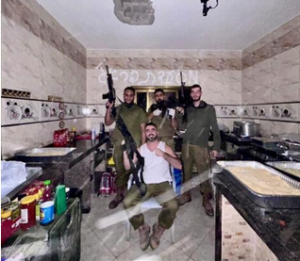The viral atrocities posted by Israeli soldiers

In an X/Twitter post, soldiers brandish their rifles inside a Palestinian home in Gaza
Sophia Goodfriend writes in Sapiens Anthropology Magazine on 20 March 2024:
In early January, a TikTok account affiliated with Israel’s ultra-Orthodox Shas party posted a video that an Israeli soldier filmed in Gaza. Somewhere in the northern part of the Strip, the soldier stands inside a bedroom in a Palestinian home. He has just finished wrapping himself in tefillin—straps with small leather boxes containing Torah scrolls that Orthodox Jewish men usually wear during morning prayers.
Over a soundtrack of pulsing dance beats, the grinning soldier exclaims in Hebrew: “I can’t believe that I am saying this. I am putting on teffilin in a house in Gaza. A house in Gaza!”
The 22-second reel offers viewers a short tour of a home left in a hurry. Handbags are shoved into a closet, clothes litter the floor, and the soldier’s gun lies on a half-made bed. “Look at this room, look at the room they have here. A palace. Let’s look a bit outside.”
Leaning out the window, the soldier pans across a ruined cityscape: building facades pocked by mortar, windows shattered by bombs, and entire blocks demolished by bulldozers. He turns the camera back on himself, gives a thumbs up, and smiles.
The TikTok post emblematizes a familiar genre of Israeli war media popularized in October 2023, when the Israel-Hamas war began, and now making the rounds in international press. For months, soldiers have been posing for the camera inside vacated living rooms or atop apartment complexes reduced to rubble. Bored as the war drags on, some update Tinder profiles with action shots. Their TikTok and Instagram reels show comrades smoking hookah, eating hummus, and praying in empty Palestinian homes. [1]
Evidence of war crimes circulate alongside the more banal aspects of soldiering. In some scenes, soldiers play backgammon while sipping tea from plundered chinaware. In others, they drape captives in Israeli flags, forcing them to sing “Am Yisrael Chai”—“the people of Israel live.”
As an anthropologist who has spent time in Israeli military archives, I found many of these scenes familiar. Over the past 75 years of bloodshed, photography has long served to trivialize the atrocities of war.
The genre is hardly unique to Israel. But today the abundance of smartphones on the battlefield, ease of social media, and unapologetic militancy of Israel’s majority have made such war photography more visible than ever.
War Trophies
The recent photographic trend began soon after Hamas militants breached the Israel-Gaza border fence and massacred around 1,200 Israelis and migrant workers on October 7, 2023. As Israel Defense Forces (IDF) troops streamed into Gaza in the weeks that followed, many framed themselves as victors in a war of retribution. The months-long operation has killed, to date, more than 30,000 Palestinians—the majority women and children—and so far has failed to bring the remaining Israeli hostages home.
Israeli social media continues to stream a montage of empty homes, blasted-out cities, and Palestinians abused or even mutilated by Israeli forces. IDF statements to international media have said the behavior “does not comply with the army’s orders” and “does not align with the expected morals and values of IDF soldiers.” But it is not clear whether any punishments or preventive measures have been issued.
In contrast, Palestinian social media documents the staggering human cost of the war: tens of thousands of civilians killed, and millions displaced to makeshift camps where they suffer hunger, dehydration, and disease.
